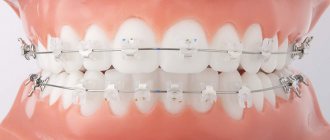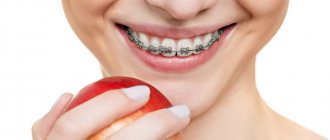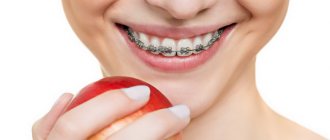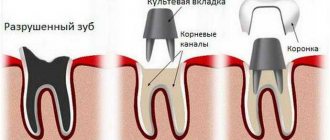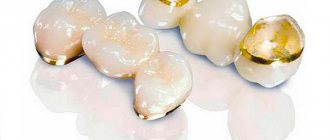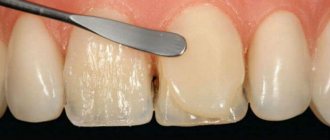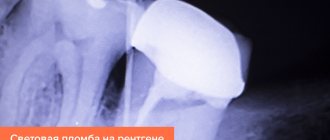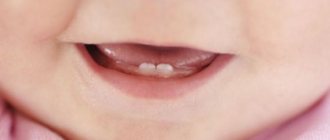Braces are an orthodontic structure that is placed on teeth to correct an overbite or irregularities in the dentition. The most common are metal and ceramic braces. Which ones should you choose and why? Let's find out what is better - metal or ceramics, and whether there are alternative options.
In this article
- Classification of braces
- What is the difference between metal braces and other types?
- Ceramic braces - what is the difference from metal braces?
- Which braces are better - metal or ceramic?
- Sapphire and plastic braces
- Combined systems
Braces are a permanent orthodontic structure that is attached to the teeth on the outside and/or inside of the jaw to correct misalignment or misalignment of the dentition. Outwardly, it resembles an arch with many small clasps on each tooth.
The braces are fixed in the grooves of the structure and glued to the enamel. They are installed for a period of one to three years, depending on medical indications and the type of orthodontic system. Which braces should you choose and why? Let's look at their main types.
Classification of braces
When choosing orthodontic braces, you need to consider the following parameters:
- Material. Braces are made of metal, ceramics, plastic, sapphire, etc. They differ in functionality, durability and service life.
- Aesthetics. Metal braces are visible on the teeth, while plastic and ceramic braces can be transparent or match the color of the enamel.
- Medical indications. Complex orthodontic problems are difficult to correct with plastic or ceramic restorations. In such cases, it is better to install metal ones.
- Duration of orthodontic treatment. It goes faster if you install metal structures.
Braces are divided not only into metal and ceramic, there are other varieties, but these two types are the most common. Orthodontic structures are also classified on other grounds, for example, the method of fixation: ligature, non-ligature, removable, self-adjusting, etc.
The choice of design is determined by medical indications, but often the dentist invites the patient to choose the material from which the orthodontic brackets will be made. To make it easier for you to decide, we will tell you which braces are better - ceramic or metal, and what advantages and disadvantages they have.
Is there a compromise?
For clients who can’t decide whether to choose ceramic or metal braces, dentists today can offer a compromise option. Its essence is to install ceramic devices on the teeth located in the smile zone, and metal ones on all others.
This combination allows you to make the cost of orthodontic treatment more affordable, preserve the aesthetics of your smile and obtain excellent therapeutic results.
Remember: braces are just a tool in the hands of a doctor. An experienced doctor knows how to eliminate a patient’s defect using different types of devices. But he offers exactly those that will make your smile more attractive more quickly and less traumaticly. Therefore, trust your doctor and strictly follow all his instructions. By following this rule, you will correct your bite very quickly.
What is the difference between metal braces and other types?
The first orthodontic braces, which were made of iron, appeared in 1955. Since then, they have remained virtually unchanged in their operating principle, but have become more convenient, smaller and safer. Such structures are made of steel, titanium or nickel. The main advantage of metal braces is their secure fit. They allow you to solve an orthodontic problem in a relatively short period of time.
There are other advantages to metal braces. Among them:
- high strength, the likelihood of damage to the structure is minimal;
- resistance to all types of dyes, metal is not stained by coffee, tea, soda and nicotine, and does not corrode;
- high hygienic characteristics, metal structures are less susceptible to bacteria;
- financial affordability: metal braces are much cheaper than ceramic braces.
Before choosing metal staples, check out their disadvantages:
- unaesthetic: metal braces look unsightly and can cause psychological discomfort in the patient, especially in a child;
- Not suitable for individuals intolerant to various metals.
However, the first point is relative. The negative attitude towards them is partly formed by cinema. Previously, in cinema, iron braces were installed on actors who had to play shy and insecure people, which is why the majority have a stereotypical opinion on this issue. Today, neat metal braces are made that do not spoil a person’s appearance and even become his highlight.
Types of bracket systems by type of fixation
The main element of braces is the arch, which creates a load, forcing the teeth to move in a given direction. Depending on the method of fixing the arch, braces are divided into:
- Ligatures
. The name comes from the small rubber bands (ligatures) that secure the wire in the system. Re-upholstery is required at least once a month. The orthodontist regulates the load, which allows more precise control of the treatment process. Individuality can be achieved using colored ligatures. - Unligated (self-ligating)
. They are more modern orthodontic devices. Instead of ligatures, the design uses a lid or a lock. They require tightening every 1.5-2 months. Suitable for those who do not have the opportunity to frequently visit the dental clinic (for example, due to frequent business trips).
Both types do an excellent job of the task, so it is impossible to recommend only one of them as the best. As a rule, the dentist provides the patient with the choice of a device based on this characteristic.
| Advantages | Flaws |
| Ligature | |
|
|
| Unligated | |
|
|
Ceramic braces - what is the difference from metal braces?
Ceramic braces are modern designs that have high aesthetic values. They do not differ in color from enamel, and therefore are practically invisible on the teeth. In addition, they are hygienic, lightweight, safe and have miniature locks that are easy to maintain. Also, ceramic braces do not cause allergies.
But they also have disadvantages. They are inferior to metal ones in efficiency. Defects that can be corrected with metal braces in one year are corrected with ceramic systems within 2-3 years. At the same time, ceramic products are much more expensive than iron ones. They are also not as durable and can break under strong mechanical stress. Thus, both types of systems have their pros and cons, which should be taken into account when selecting materials.
Features of ceramics
Ceramic devices were created specifically for patients who are accustomed to having a perfect smile. In color they almost completely match the enamel, so they are hardly noticeable to others.
Like metal analogues, they come in:
- ligature - fixed on the front surface of the dentition;
- non-ligature - adjustable using special clips.
Among the undeniable advantages of ceramics, orthodontists name:
- excellent hygiene;
- good aesthetics;
- absence of bulky locks;
- sufficient strength.
They do not provoke allergies, and therefore are an ideal solution for allergy sufferers.
At the same time, they are less durable than metal ones, and break more often; they can be painted with food coloring. They are larger in size than metal ones. They cost more.
The most modern ceramic devices for correcting bites
Damon Clear ceramics are in high demand among patients today. Its distinctive feature is one hundred percent resistance to pigmentation. Reflection devices from Ortho Technology have also proven themselves well. They are made from special aluminum oxide polycrystals and do not leave stains on tooth enamel or cause discoloration.
The Mistique GAS designs are considered a worthy option. They are coated with silicon oxide, and therefore also do not absorb coloring particles and maintain the natural color of the enamel.
Which braces are better - metal or ceramic?
People who play sports will benefit from metal braces as they are more durable. They will also be better for those who want to fix a defect in a shorter time. Ceramic braces should be chosen by people who want to hide orthodontic treatment from others or who are allergic to metal. In general, ceramics do their job just as well as iron, but a little slower.
Currently, it is possible to get braces that are half ceramic and half metal. The doctor installs an arch with ceramic locks on the smile zone, and metal on the molars and premolars. Such treatment will cost slightly more. If price or wearing time are not determining factors for you, you can opt for other materials.
Main differences between metal and ceramics
If we compare the described products with each other, then we need to focus on four main factors:
- Reliability. According to this criterion, metal devices win.
They can easily withstand any mechanical stress, so they remain intact throughout the entire treatment period. Ceramics is inferior in strength, but when used correctly (if the patient strictly follows all medical recommendations) it also wears quite well. However, it is not recommended for professional athletes to install it. - Appearance. Ceramic braces are unnoticeable. They almost match the natural color of the teeth, so they are suitable for people who lead a public lifestyle and speak in public. Metal does not look as aesthetically pleasing and creates a pronounced contrast on the dentition. However, if you plan to use it, you can ask the orthodontist to use arches that are fixed on the inner surface of the teeth. But they are so expensive.
- Price. Ceramic devices are inferior here - they are more expensive, so not every patient in a dental clinic can afford such treatment. Metal has a more reasonable price. This is its main advantage.
- Convenience. According to user reviews, ceramics cause slightly less discomfort. Therefore, if a person has a low pain threshold, he should give preference to braces made of this material.
In any case, the final decision must be made together with your doctor. After all, the main goal of orthodontic therapy is to give certain teeth the correct position. And the emphasis in this situation should no longer be on beauty, but on functionality and a guarantee of obtaining the expected result in the shortest possible time.
Sapphire and plastic braces
Plastic staples are considered the cheapest. Light, safe and invisible, as they are completely transparent. Their disadvantage is that they are not suitable for severe dental diseases. In addition, they are not as durable as metal or ceramic braces. Also, plastic products may darken over time if a person often drinks drinks with coloring substances.
Sapphire structures are made from synthetic sapphire, which remains perfectly transparent throughout the entire time you wear braces. In addition, sapphire systems are much stronger than metal, ceramic and plastic. There is virtually no risk of breakdowns. Designs made from synthetic sapphire are suitable for people who need “invisible” treatment or play sports. Also, sapphire braces, which have small locks, are convenient to install for patients whose lower teeth are small. The only disadvantage of such systems is their high cost.
Manufacturers of popular types of braces
In the field of manufacturing braces, there are leaders whose products are of guaranteed high quality. If you want to supply the best orthopedic structures, pay attention to devices from the following manufacturers:
- Ormco
. A worldwide popular US concern that has been offering high-quality braces since the middle of the last century. The main direction is the production of steel, titanium and ceramic models. - Forestadent
. German manufacturer of metal braces, which are considered the most popular in most civilized countries of the world. The brand's products are approved by the Dental Society. The company is actively developing and the range of bracket systems has recently been supplemented with lingual models. - Top Service
. A laboratory from Germany, which became famous for producing the revolutionary Incognito bite correction system. Today this brand is represented in Russian dental clinics with comfortable and thin brace systems that are almost invisible when worn.
When choosing the optimal and best type of braces for installation, pay attention to the brand, originality of the design (since there are fakes) and manufacturer’s warranties. In combination with the right type of material, method of fixation and installation location, you are guaranteed to get the desired effect in the shortest possible time. The most important thing is to find a competent and experienced orthopedic dentist who will help you with the choice and will efficiently perform all procedures for installing braces.
Combined systems
There are also systems more complex in design and functionality used in dentistry. We are talking about hybrid or combined orthodontic brackets, for example:
- lingual-vestibular;
- metal-ceramic;
- metal-sapphire;
- ligature-self-regulating, etc.
There can be many such combinations. Braces systems are constantly being modernized and becoming more and more functional. Hybrid designs can combine aesthetics, versatility, reliability, strength, etc. But they require large financial investments from the patient and high professionalism from the dentist.
It is worth remembering that the effectiveness of treatment is determined not only by the type of structure. Much depends on how a person cares for his teeth and braces. To keep them intact and prevent the development of caries, you must adhere to a number of recommendations:
- stop smoking and alcohol;
- buy a special brush and brush for berkets;
- use dental floss and irrigators;
- limit your consumption of sweets;
- give up solid foods;
- Avoid sticky foods and drinks with dyes.
When purchasing toothpastes, mouthwashes and other hygiene products, choose products that are recommended for orthodontic treatment.
When should correction begin?
Braces are considered one of the most popular dental structures for correcting malocclusion. Indications for installing braces are determined by the dentist after diagnostics, during which a malocclusion or other problems that require special correction may be detected. The main indications are:
- Different types of malocclusion. Malocclusion is not always pronounced; in many patients it is diagnosed during an examination for another reason and does not cause any concern in everyday life. However, proper correction can improve the appearance of the smile in cases of mild problems, while in cases of significant problems, installing braces is one of the most affordable treatment options.
- Dystopia of teeth. If the position of one or more teeth in the dentition is disturbed, then the braces system will correct this deficiency over time.
- Presence of gaps between teeth. Gaps between teeth are an unpleasant aesthetic defect that can be easily corrected with braces.
- Crowded teeth. If teeth are too close to each other, this makes oral hygiene difficult and contributes to the development of caries.
- Disproportion between the upper and lower jaws. During development, the disorder may occur due to bad habits such as thumb sucking, the child's habit of pulling and gnawing hard objects.
If there are medical indications, the dentist recommends that the patient choose one of the options for modern braces and begin preparing for treatment.
Types of metal braces
Based on the type of fastening, the following types of orthodontic structures are distinguished:
- Vestibular. They are used more often than others. They are attached to the outside of the dentition, which is why they cannot be made invisible.
- Lingual. They are fixed on the side of the tongue inside the dentition. They are absolutely invisible - for others to see them, you need to open your mouth wide. Because of this arrangement, they take longer to correct anomalies, and during the adaptation period problems may arise - impaired diction, damage to the tongue. They cost significantly more.
According to the method of fastening the arch, there are the following types of metal braces:
- Ligatures. Visually, a more massive option due to the presence of ligatures - steel wire or elastic bands. They are needed to fix the arc to each lock. They exert more pressure and are more difficult to get used to.
- Self-ligating. The metal self-ligating bracket system is the most modern and progressive. Unlike ligatures, the arc is fixed under the cover of each lock and is not pressed against the groove; it can slide. Because of this, the pressure is less, it is easier for the patient to get used to the design, the doctor needs to be visited less frequently, and the duration of treatment is reduced by an average of a third.
Ligature metal braces
Main manufacturers:
- Series Q, Q2 and 3MX – metal self-adjusting braces, reliable and comfortable. The all-metal design features a patented SpinTek cap mechanism that allows the arc to slide freely with minimal friction.
- 3M Unitek. Victory models have an anatomical shape of the locks and a special surface, thanks to which you can securely attach the braces to the teeth with minimal risk of coming off. Budget series of orthodontic structures.
- Ortho Technology. “Marquis” systems are braces with a low profile, making them easier to care for and ensuring wearing comfort.
- "Pilot". Russian-made design with an affordable price. Innovations are not used here, but the braces cope with their main task.
- Dentsply G.A.C. In-Ovation braces are self-ligating, the line includes metal systems (R). There is a unique locking mechanism that holds the arc, and the mesh covering of each lock makes it easier to attach and more stable. The braces are slightly curved and follow the anatomical shape of the tooth.
- BioQuick models are non-ligature vestibular-type structures. Available in metal and ceramic. The peculiarity of metal ones is that there is no nickel in the alloy, so the risk of allergies in the patient is minimal. Aesthetics and comfort for the patient are ensured by the low profile of the plates, and the rounded edges reduce the likelihood of injury or chafing of the mucous membrane. The manufacturer has patented a unique technology - there are grooves on the platform, due to which it adapts to the characteristics of the tooth and is firmly attached.
An important difference between metal braces and ceramic braces is reliability and durability. The latter are more fragile, which is why they are often made more massive - they are almost invisible on the teeth, but they take up more space in the mouth and can create discomfort and difficulties during adaptation.
